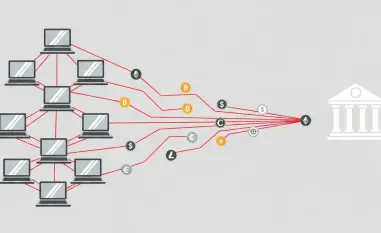Phishing attacks are constantly evolving in complexity and sophistication, posing significant challenges to traditional cybersecurity measures. Modern cyber attackers employ ever more cunning techniques, necessitating the continuous upgrade and enhancement of analytical tools to effectively combat these threats. ANY.RUN’s interactive sandbox stands out as an advanced tool designed to aid in the detailed and effective analysis of phishing attacks, assisting professionals in staying ahead of cyber criminals.
The Importance of Identifying and Analyzing Phishing Attacks
Evolving Threat Landscape
Phishing attacks evolve incessantly, employing ingenious methods to bypass traditional defenses and exploit vulnerabilities. As cyber attackers become more sophisticated, it is crucial for analytical tools to keep pace, necessitating continuous upgrades and advancements to thwart phishing attempts effectively. The dynamic nature of phishing schemes underscores the necessity for cybersecurity measures to be equally dynamic and adaptive.
The evolving threat landscape compels cybersecurity professionals to employ advanced tools to recognize and neutralize these attacks. Static defenses are no longer sufficient; instead, dynamic and adaptive tools capable of evolving in response to new threats are essential. In this context, analytical tools must be upgraded and enhanced continually to match the technical acumen of cyber attackers, ensuring robust defense mechanisms capable of handling sophisticated threats.
Role of MITRE ATT&CK Matrix
A significant starting point for identifying threats and collecting Tactics, Techniques, and Procedures (TTPs) is the MITRE ATT&CK Matrix, which has been integrated into ANY.RUN’s Threat Intelligence (TI) Lookup homepage. This matrix links various malware analysis sessions to practical tactics and techniques, streamlining the discovery of phishing techniques and their corresponding sub-techniques. The integration of the MITRE ATT&CK Matrix into ANY.RUN’s platform aids in identifying new and emerging phishing samples while also offering actionable insights that can be utilized in real-world scenarios.
The MITRE ATT&CK Matrix is more than just a tool; it’s a strategic asset that provides a structured framework for understanding the specific actions of cyber adversaries. By incorporating the MITRE ATT&CK Matrix, ANY.RUN enhances its ability to deliver detailed, tactical insights that support robust threat detection and response. This thoughtful integration allows users to gain a deeper understanding of the behaviors and intentions behind phishing attacks, enabling more precise and effective mitigation strategies.
Real-World Phishing Attack Examples
Phishing Email with an Excel Attachment and a Link Inside
One sophisticated phishing tactic involves an email containing an Excel file with embedded links that redirect users to malicious websites or deliver malware. ANY.RUN’s sandbox securely analyzes such threats, providing a detailed observation of the malicious activity. When an Excel file is opened using ANY.RUN, it reveals an embedded Dropbox logo intended to lend credibility to the file. Clicking on the link within the Excel file navigates the user to a malicious website that asks for Microsoft account credentials, raising red flags with a suspicious URL that flags the phishing attempt.
Network indicators and threat triggers within ANY.RUN’s platform further confirm the malicious nature of this activity, reinforcing the analysis findings and providing comprehensive insight into the attack. This multi-layered approach to understanding the attack’s mechanisms allows for a robust defense, capturing critical indicators that reveal the attack’s intent and scope. By dissecting such phishing emails, cybersecurity professionals can develop targeted countermeasures that address specific vulnerabilities exploited by these attacks.
Phishing Email with an Archive Containing an SVG File
Another sophisticated phishing method begins with an email attachment containing a ZIP archive that hides an SVG file, which in turn downloads an encrypted archive containing the AsyncRAT payload. Although the SVG file may initially appear harmless, clicking on an embedded button within the document redirects the user to download another encrypted ZIP file. The attackers cleverly embed the password for this second ZIP file in the initial phishing email, adding a layer of complexity to the attack.
Once the ZIP file is extracted with the provided password, it reveals the AsyncRAT malware, which gives attackers remote control over the victim’s system. ANY.RUN’s sandbox provides a secure environment for analyzing this type of phishing attack, displaying indicators of malicious activity and helping to unravel the multi-step process involved. The detailed analysis offered by ANY.RUN’s platform enables cybersecurity professionals to understand the intricacies of such phishing schemes, allowing them to identify key points of compromise and take appropriate protective measures.
Phishing Attack Containing a PDF File
Seemingly harmless PDF files can initiate complex multi-step processes designed for credential theft. This type of phishing attack often involves malware such as Storm1747 and Tycoon, which are engineered to bypass traditional security measures. When a user opens the PDF in ANY.RUN’s sandbox, it triggers a button prompt that leads to a series of redirects. These redirections often involve exploiting weaknesses in Cloudflare’s human verification process, adding further complexity to the attack.
Eventually, the user is directed to a fake Microsoft login page that requests the victim’s credentials. The complexity and length of the URL used in this fake login page can often flag it as suspicious. ANY.RUN’s interactive sandbox highlights the PDF’s malicious behavior, underscoring the presence of malware like Storm1747 and Tycoon. This detailed scrutiny aids in pinpointing the specific mechanisms through which the attack operates, providing valuable insights that can be used to develop more effective defenses against such sophisticated threats.
Common Themes and Indicators in Phishing Attacks
Exploitation of Innocuous-Looking Documents
A common theme across various phishing attacks is the exploitation of innocent-looking documents or files. Attackers frequently use legitimate logos or design elements to deceive victims and mask their malicious intent. Documents such as Excel files, SVG files, and PDFs are designed to appear harmless, increasing the likelihood that recipients will open them without suspicion. The sophisticated design and superficially credible appearance of these documents often contribute to the initial success of phishing attempts.
Additionally, the URLs embedded within these documents are often complex and misleading, making it difficult for users to identify them as malicious at first glance. The multi-layered redirection pathways further complicate detection, requiring advanced tools capable of dissecting and analyzing these elements effectively. Recognizing and understanding these common themes are crucial for cybersecurity professionals, as it allows them to anticipate and counter phishing schemes more proactively.
Recognizing Phishing Indicators
To effectively counteract phishing attacks, recognizing key indicators is essential. Suspicious attachments, such as Excel files, ZIP archives, or PDFs with unexpected links, often serve as initial warnings. Misleading URLs characterized by complexity, length, or random characters are another significant red flag. Requests for credentials, typically presented through fake login pages mimicking trusted platforms, are a clear indicator of phishing attempts. Additionally, multiple redirects or verification steps and the imitation of recognized brands through logos and designs are tactics used by attackers to establish trust and deceive victims.
By leveraging these indicators and utilizing advanced tools like ANY.RUN’s interactive sandbox, cybersecurity professionals can uncover phishing attempts and mitigate associated risks effectively. Detailed analysis of these phishing schemes, provided by sophisticated tools, helps in understanding attack patterns and developing robust defenses. The ability to recognize and act upon these indicators empowers professionals to safeguard their networks and systems against increasingly sophisticated phishing threats.
Leveraging Advanced Analytical Tools
ANY.RUN’s Interactive Sandbox
ANY.RUN’s interactive sandbox plays a pivotal role in analyzing phishing indicators, providing a secure and detailed environment for uncovering malicious activities. This advanced tool allows users to interact with potentially dangerous files in a controlled setting, observing the behavior of suspicious attachments, URLs, and scripts. By simulating real-world conditions, ANY.RUN’s sandbox provides comprehensive insights into the functioning of phishing attacks, enabling professionals to identify nuances and develop precise countermeasures.
The broader consensus in the cybersecurity community underscores the crucial role of advanced analytical tools in combating evolving threats. Tools like ANY.RUN’s interactive sandbox are indispensable in enhancing security efforts, offering detailed and safe analysis of various phishing threats. By dissecting the mechanics of these attacks, ANY.RUN’s platform equips cybersecurity professionals with the knowledge needed to counteract sophisticated phishing schemes effectively, ensuring robust protection for their networks.
Continuous Adaptation in Cybersecurity
Phishing attacks are constantly evolving, becoming more intricate and sophisticated, which presents substantial challenges to traditional cybersecurity defenses. Modern cyber attackers utilize increasingly deceptive techniques, making it essential to continually upgrade and enhance analytical tools to effectively counter these threats. Analysts need to be proactive and innovative, using modern solutions to stay ahead in the cybersecurity landscape.
ANY.RUN’s interactive sandbox has emerged as a cutting-edge tool that greatly aids in the comprehensive and effective analysis of phishing attacks. This advanced platform allows cybersecurity professionals to scrutinize and dissect phishing methods meticulously, offering a hands-on environment to understand and counteract the ever-changing tactics used by cyber criminals. It provides detailed insights and interactive features that help identify vulnerabilities and devise strategies to combat them. By leveraging this powerful tool, professionals can stay one step ahead, ensuring robust defenses against the continually evolving landscape of cyber threats.













